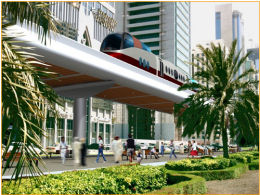Posted 15th February 2008 | 1 Comment
Driverless trains to beat road congestion in desert city

An artist's impression of a Metro train on an elevated part of the route on Sheikh Zayed Road
Felix Schmid is associate professor in railway systems engineering in the civil engineering department of the University of Birmingham.
During a recent visit to Dubai, part of the United Arab Emirates, he saw at firsthand some of the civil engineering preparations for the huge projects to build metro and main line rail systems in a city which is fast becoming one of the world's premier holiday and property destinations.
In this special article for Railnews he explains why rail is destined to become vital to the expanding desert city.
Developing a rail network the size of London’s in just 20 years is a tall order, but Dubai is planning to do just that – from a standing start.
The city plans to build 318 km of metro, 268 km of tram-way and 30 km of mainline railway by 2025.
Why? The road network is at breaking point in this rapidly growing Middle Eastern city with a current population of about 1.5 million people.
There is simply no space to accommodate the traffic that will be generated by the three million inhabitants expected by 2017 and the seven million who will live in the city once it is fully developed.
After 10 years of planning, construction of the metro by a Mitsubishi-led consortium started in February 2006.
As designed by the city’s Roads and Transport Auth-ority (RTA), the metro network will relieve the chronic road traffic congestion that can turn a three-mile trip into a one hour journey.
It will absorb a large proportion of the huge number of commuters working in Dubai’s formidable business district and hotel sector, many of whom travel from the neighbouring emirates of Abu Dhabi and Sharjah.
The metro will also serve the planned Al Maktoum International Airport at Jebel Ali – set to be the world’s biggest. The Red, Blue and Purple metro lines will all terminate at the new airport.
Currently under construction by an international consortium are two lines: The 50 km Red Line with 29 stations (four underground) and the 18 km Green Line with 14 stations (six underground).
Most of the rapid transit system will be elevated to minimise impact on the existing road network. It will be similar to the Docklands Light Railway (DLR) in both capacity and technology, with automated driverless trains supplied by Kinki Sharyo.
The similarity does not end there: the operating contract for the Red and Green Lines has been placed with Serco, the operator of DLR, who expect to run the first trains in 2009.
Trains and stations will be air-conditioned to cope with Dubai’s high ambient temperatures, with platform screen doors to minimise energy use.
The many above-ground stations will be of a striking standard design, with a strong beacon function.
Our pictures illustrate the progress of the project and highlight the rate of urban change in Dubai. The elevated structure of the metro has forced the closure of a pedestrian bridge that was const-ructed just two years ago.
The bus network will be integrated with the metro and will be upgraded to attract a larger cross-section of the population. At present, 1,000 air-conditioned bus-shelters are being constructed throughout the city, as part of an advertising contract.
A tram network is required to serve the utopian Palm Deira development on re-claimed land, as well as the shopping centres, leisure and educational facilities being developed in Dubai.
The RTA’s master plan (pictured below) shows the tram route around the periphery of the biggest of the three Palms developments – expected to house in excess of one million people – in light blue, with the mainland urban routes in black.
The RTA is also working on the realisation of the main line railway that will link all of the Emirates. This is now expected to run inland to minimise the impact on the precious sea-front environment.
With Parsons Brinckerhoff, Systra and a number of other international consultancies involved, there is likely to be ample work for Britain’s railway engineers and operators until Dubai and the other emirates of the UAE complete their rail infrastructures.
Reader Comments:
Views expressed in submitted comments are that of the author, and not necessarily shared by Railnews.

Khalil ahmed Shaikh, LONDON, ENGLAND
This is fantastic news as i work for Network Rail and hope to work in UAE in the neare future as this open new doors to new rail interface.Hope i can make a contrbution to the projects.